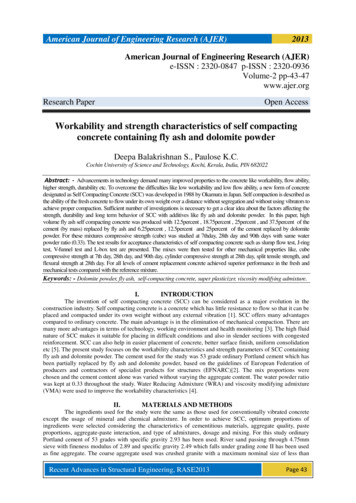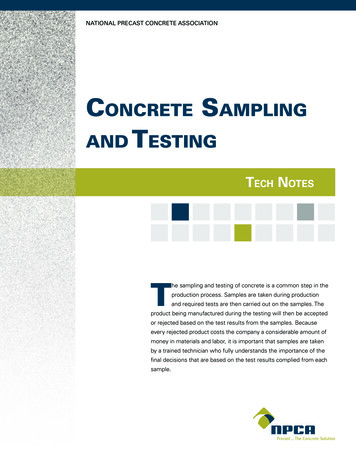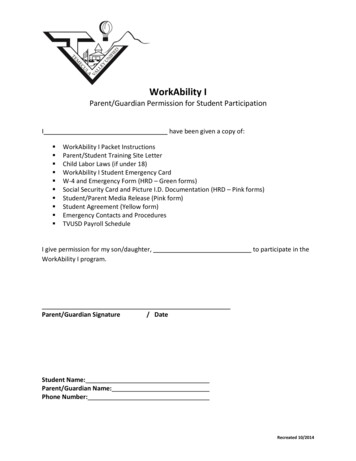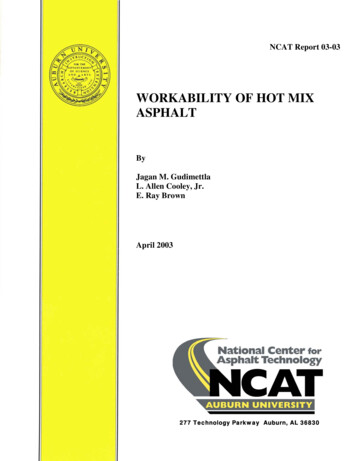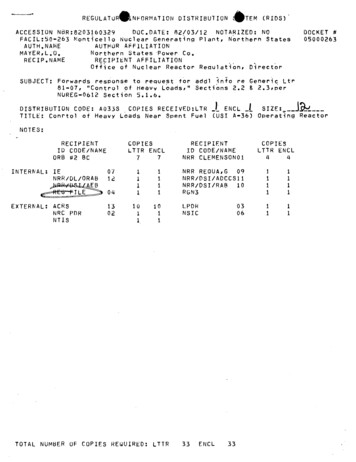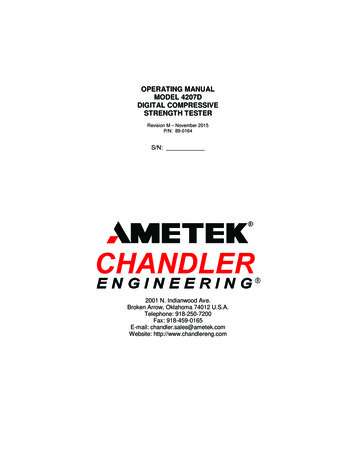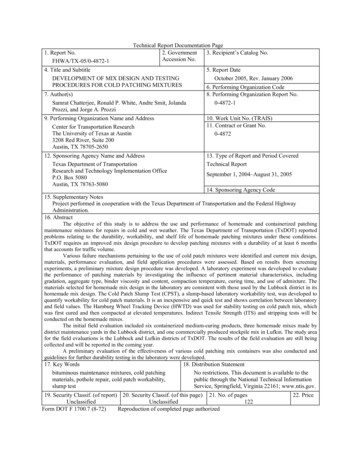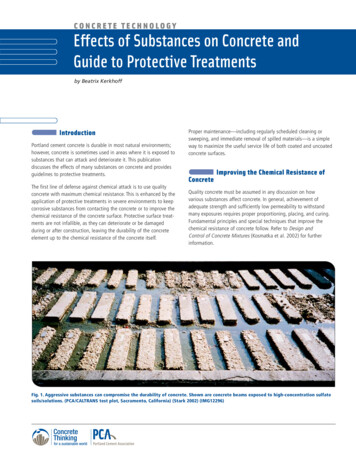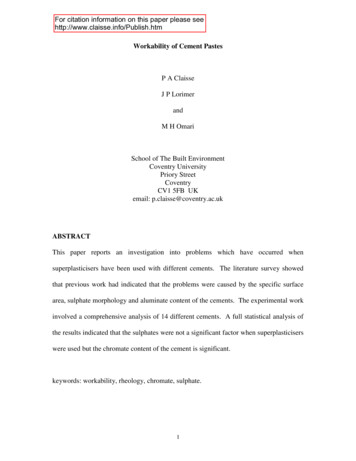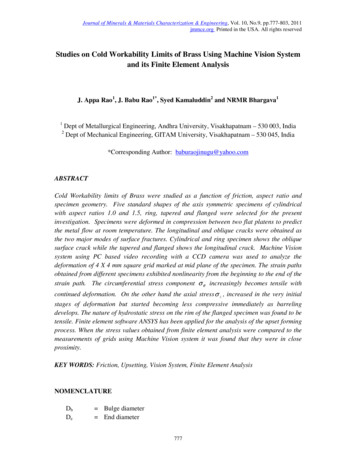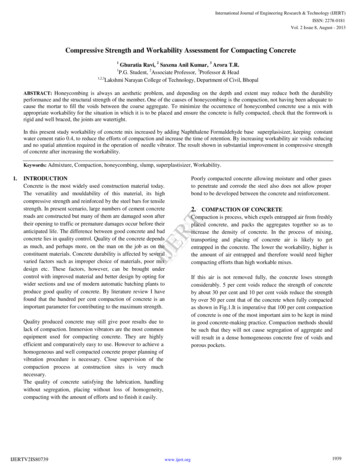
Transcription
International Journal of Engineering Research & Technology (IJERT)ISSN: 2278-0181Vol. 2 Issue 8, August - 2013Compressive Strength and Workability Assessment for Compacting Concrete1Ghuratia Ravi, 2 Saxena Anil Kumar, 3 Arora T.R.P.G. Student, 2Associate Professor, 3Professor & Head1,2,3Lakshmi Narayan College of Technology, Department of Civil, Bhopal1ABSTRACT: Honeycombing is always an aesthetic problem, and depending on the depth and extent may reduce both the durabilityperformance and the structural strength of the member. One of the causes of honeycombing is the compaction, not having been adequate tocause the mortar to fill the voids between the coarse aggregate. To minimize the occurrence of honeycombed concrete use a mix withappropriate workability for the situation in which it is to be placed and ensure the concrete is fully compacted, check that the formwork isrigid and well braced, the joints are watertight.In this present study workability of concrete mix increased by adding Naphthalene Formaldehyde base superplasisizer, keeping constantwater cement ratio 0.4, to reduce the efforts of compaction and increase the time of retention. By increasing workability air voids reducingand no spatial attention required in the operation of needle vibrator. The result shown in substantial improvement in compressive strengthof concrete after increasing the workability.Keywords: Admixture, Compaction, honeycombing, slump, superplastisizer, Workability.INTRODUCTIONConcrete is the most widely used construction material today.The versatility and mouldability of this material, its highcompressive strength and reinforced by the steel bars for tensilestrength. In present scenario, large numbers of cement concreteroads are constructed but many of them are damaged soon aftertheir opening to traffic or premature damages occur before theiranticipated life. The difference between good concrete and badconcrete lies in quality control. Quality of the concrete dependsas much, and perhaps more, on the man on the job as on theconstituent materials. Concrete durability is affected by severalvaried factors such as improper choice of materials, poor mixdesign etc. These factors, however, can be brought undercontrol with improved material and better design by opting forwider sections and use of modern automatic batching plants toproduce good quality of concrete. By literature review I havefound that the hundred per cent compaction of concrete is animportant parameter for contributing to the maximum strength.Poorly compacted concrete allowing moisture and other gasesto penetrate and corrode the steel also does not allow properbond to be developed between the concrete and reinforcement.2. COMPACTION OF CONCRETECompaction is process, which expels entrapped air from freshlyplaced concrete, and packs the aggregates together so as toincrease the density of concrete. In the process of mixing,transporting and placing of concrete air is likely to getentrapped in the concrete. The lower the workability, higher isthe amount of air entrapped and therefore would need highercompacting efforts than high workable mixes.IJERT1.Quality produced concrete may still give poor results due tolack of compaction. Immersion vibrators are the most commonequipment used for compacting concrete. They are highlyefficient and comparatively easy to use. However to achieve ahomogeneous and well compacted concrete proper planning ofvibration procedure is necessary. Close supervision of thecompaction process at construction sites is very muchnecessary.The quality of concrete satisfying the lubrication, handlingwithout segregation, placing without loss of homogeneity,compacting with the amount of efforts and to finish it easily.IJERTV2IS80739www.ijert.orgIf this air is not removed fully, the concrete loses strengthconsiderably. 5 per cent voids reduce the strength of concreteby about 30 per cent and 10 per cent voids reduce the strengthby over 50 per cent that of the concrete when fully compactedas shown in Fig.1.It is imperative that 100 per cent compactionof concrete is one of the most important aim to be kept in mindin good concrete-making practice. Compaction methods shouldbe such that they will not cause segregation of aggregate andwill result in a dense homogeneous concrete free of voids andporous pockets.1939
International Journal of Engineering Research & Technology (IJERT)ISSN: 2278-0181Vol. 2 Issue 8, August - 2013100806040200051015202530Fig.1. Loss of strength of concrete due to incompletecompactionPermeability is also increased by insufficient compaction,resulting in easy entry for aggressive chemicals in concrete,which attack concrete and reinforcement to reduce thedurability of concrete.In order to achieve full compaction and maximum density, withreasonable compacting efforts available at site, it is necessaryto use a mix with adequate workability.3.5. RESEARCH SIGNIFICANCE:Many a times honey combing or exposed rusted reinforcementsare seen on the surface of concrete structures. The main causesof honeycombing are improper compaction, the layman usingvibrator and stiff concrete. If compaction delayed, the mixbecomes more stiff, then they added extra water to fluidise themix, this extra water leakage from shuttering along withcement, and honey comb appeared on the surface. Thereforeadequate workability should be adopted by adding admixtures(plastisizer, superplastisizers, retarder etc.) to achieve hundredper cent compaction by less efforts of compaction at samewater/ cement ratio.IJERTCOMPACTING METHODS :There are two methods are commonly used for compaction ofconcrete at site works:(i) Hand compaction: - This is adopted in case of unimportantconcrete works of small magnitude. Hand compaction consistsof rodding, ramming or temping. When hand compaction isadopted, the consistency of concrete is maintained at higherlevel. The compaction by hand, if properly carried out onconcrete with sufficient workability, gives satisfactory results,but the strength of the hand compacted concrete will benecessarily low because of higher water cement ratio requiredfor full compaction.(ii) Compaction by Vibrator:- Immersion vibrator and surfacevibrator or screed vibratory are commonly used in highwaystructures. Both vibrators are simultaneously used in deck slab,rigid pavement etc. Some times form work vibrator also used inprecast works and heavy reinforced concrete works.Where strength is required, it is necessary that stiff concrete,with low water cement ratio be used. To compact suchconcrete, mechanically operated vibrator are used.The vibrators impart a vibratory force into the concrete througha combine effort of frequency and amplitude. The effectivenessof an immersion vibrator is dependent on its frequency andamplitude. The amplitude is dependent on the size of needle,the eccentric moment and the needle weight. The area ofvibrating needle action is 100 times the cross sectional area ofthe needle in concrete having 25mm to 35 mm slump, forexample radius of action of 60mm diameter vibrator needleshall be 300 mm.4. WORKABILITYOFCONCRETE:The behavior of green or fresh concrete from mixing up tocompaction depends mainly on the property called workabilityof concrete. Workability of concrete is a term which consists ofthe following four partial properties of concrete namely,Mixability, Transportability, Mouldability and compactibility.In general terms, workability represents the amount of workwhich is to be done to compact the concrete in a given mould.The desired workability for a particular mix depends upon thetype of compaction adopted and the complicated nature ofreinforcement used in reinforced concrete.Workable concrete is the one which exhibits very little internalfriction between particle and particle or which overcomes thefrictional resistance offered by the formwork surface orreinforcement contained in the concrete with just the amount ofcompacting efforts forthcoming.The factors helping concrete to have more lubricating effect toreduce internal friction for helping easy compaction are givenbelow:a. Water contentb. Size of aggregatesc. Surface texture of aggregated. Use of admixturese. Mix proportionsf. Shape of aggregatesg. Grading of aggregatesIJERTV2IS80739www.ijert.org6. EXPERIMENTAL PROGRAMME:The main aim of this experimental programme was to study theeffect of different workability of mix to achieve hundred percent compaction by less efforts of compaction. The workabilityof concrete increased by adding different dosage ofsuperplastisizer at constant water cement ratio for pavementquality concrete M40 grade. The important property ofconcrete, compressive strength also studied. Mix design forPQC (M 40) was carried out as per the guidelines laid in IS10262, IRC 44 and IRC SP: 23.7. MATERIALS AND PROCEDURE:Ordinary Portland Cement (OPC) 43 grade confirming toIS:8112-1989 was used. The various properties of cementshows in table-1. Locally available sand and aggregate wereused in the experimentation.1940
International Journal of Engineering Research & Technology (IJERT)ISSN: 2278-0181Vol. 2 Issue 8, August - 2013Table-1. Properties of CementParticularsTest ResultsIS Code LimitsSpecific gravity3.15Not specifiedFineness (m2/kg )273225minimum.Standard Consistency %27Initial setting time (min)15030 minimumFinal setting time (min)200600 max.Soundness of cementLe-chat Expansion %1.0Compressive strength3- Days in MPa7- Days in MPa28-Days in Mpa32.642.958.010 max.23 min33 min.43 min.Table-3. Properties of Coarse AggregateParticularsTest ResultsSpecific gravity2.65Fineness modulus16.08Impact value %14.16Flakiness index %16.37IJERTMaximum size of aggregate used in the mix was 20 mm. Thepreliminary tests on fine aggregate and coarse aggregate wereconducted as per IS: 2386-1975 and IS: 383, results of thepreliminary tests are given in table 2 and 3. The fine aggregatewas confirming to zone II. The admixture superplastisizerRheobuild 1126 has been used for the present investigation.The technical details of superplastisizer (conforming to IS:9103-1979) as given by the manufacturer’s literature are givenin table No. 4.The fine aggregate, cement and coarse aggregate were drymixed, approximately 80% of calculated quantity water (w/c 0.4) was added into the dry mix and entire mass was mixedhomogeneously. Now the superplastisizer was added in theremaining 20% water and this liquid was added to the concrete.The concrete was mixed again, the workability test (slump test)were conducted, Table 5 shows the slump test results. After 45min, the concrete was remixed by hand using a shovel justenough to counteract any bleeding or segregation and slump ofconcrete was determined, and found same slump. Thishomogeneous concrete mass was poured into the cube mouldsin three layers, Set-A cube was temped 35 strokes in eachlayers and others cubes were temped 1/3rd times of standardtemping (35 strokes) i.e. 12 strokes in each layer by standardtemping bar. After consolidation the top surface was finishedsmooth and they were covered with wet gunny bags. After 24hours, the specimens were demoulded and transferred to thecuring tank where in they allowed to cure for 7 days. After 7days of water curing, the specimens were weighed and testedfor compressive strength under compressive testing machine asper IS:516-1959.Table-2. Properties of Fine AggregateParticularsTest ResultsSpecific gravity2.59Fineness modulus2.75Water absorption %0.74Grain size distributionZone IITable -4. Properties of Superplstisizer, Rheobuild 1126Concrete mix of grade M40 chosen for the presentinvestigation. A total of 6 castings have been made, out ofwhich the first is a control mix of M40 gave a slump 46mm. Ineach casting 3 cubes are cast. The next set of 5 castings are atvariable dosage of super plastisizer of 0.2%, 0.4%, 0.6%, 0.8%and 1.0% of weight of cement.IJERTV2IS80739www.ijert.orgParametersTest ResultsPhysical stateDark Brown free flowing liquidChemical name of activeIngredientNaphthalene FormaldehydePolymerRelative Density at 250C1.251pH7.80.0016Dry Material Content47.751941
International Journal of Engineering Research & Technology (IJERT)ISSN: 2278-0181Vol. 2 Issue 8, August - 2013Table – 5. Slump test for different dosage ofsuperplastisizer.200150Dosage of Superplastisizer Slump inSetBy weight of cementmmNil46 mmB0.20 %52 mmC0.40 %61 mmD0.60 %73 mmE0.80%100 mmF1.00%180 mmSlump in mmARemarks10050000.20.40.60.811.2Dosage of Superplasisizer ---------- Concrete segregatedFigure -2 Dosages of Superplastisizer vs Slump in mmTable 6. Compressive Strength Test resultsWeight ofcube 018.60B0.20 %22.6024.3019.800.40 %24.7026.1023.80760278007512CIJERT7 days Compressivestrength of concreteN/mm2Set747975067461749075307420D0.60 35083658315IJERTV2IS807397 days Compressive strength40Dosage ofSuperplastisizerBy weight ofcement30201000.20.40.60.81Dosage of Superplasisizer ---------- Figure -3 Dosages of Superplastisizer vs Compressivestrength.8. EFFECT ON COST:The initial cost of the concrete pavement is increased by addingsuperplastisizer, but the strength and durability of concreteincreased and maintenance cost and life cycle cost decreased.9. CONCLUSION :On basis of observation honeycombing free concrete can becasted by increasing workability. Strength and durability ofconcrete will also increased by small addition of admixtures.The design of concrete mix should be at higher workability andadmixtures must be added for durable concrete.www.ijert.org1942
International Journal of Engineering Research & Technology (IJERT)ISSN: 2278-0181Vol. 2 Issue 8, August - 201310.REFRENCEIRC 44 : 2008 “Guidelines for Cement Concrete MixDesign For pavement.2.IS : 2505 : 1992 – Concrete Vibrators – Immersion TypeGeneral requirement (Third Revision).3.IS 10262 : 1999 “ Recommended Guidelines for ConcreteMix Design”.4.IS 1199 : 1959 Method of Sampling and Analysis ofConcrete. Bureau of Indian Standard, New Delhi.5.IS 2386: 1963 “Method of Test for Aggregates forconcrete “.Bureau of Indian Standard, New Delhi.6.IS 383 : 1970, “ Coarse and Fine Aggregate from NaturalSources of Concrete” Bureau of Indian Standard, NewDelhi.7.IS 516 : 1959, “Methods of Test for Strength ofConcrete”. Bureau of Indian Standard, New Delhi.8.IS 9103 : 1999 “Admixtures for concrete”. First Revision,Bureau of Indian Standard, New Delhi.9.M.S.Shetty and S. Chand, Concrete Technology Theoryand Practice.IJERT1.10. MoRTH Specification for Road and Bridge Works(2001), Fourth Revision.11. Report on Compaction of Concrete by ImmersionVibrators for Durable Highway Structures bySuprioGhose.IJERTV2IS80739www.ijert.org1943
By increasing workability air voids reducing and no spatial attention required in the operation of needle vibrator. The result shown in substantial improvement in compressive strength of concrete after increasing the workability. Keywords: Admixture, Compaction, honeycombing, slump, superplastisizer, Workability. 1. INTRODUCTION
